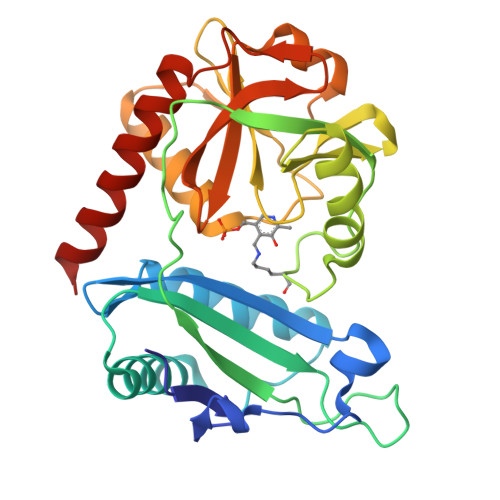Multifunctionality of arginine residues in the active sites of non-canonical d-amino acid transaminases.
Bakunova, A.K., Matyuta, I.O., Minyaev, M.E., Isaikina, T.Y., Boyko, K.M., Popov, V.O., Bezsudnova, E.Y.(2024) Arch Biochem Biophys 756: 110011-110011
- PubMed: 38649133
- DOI: https://doi.org/10.1016/j.abb.2024.110011
- Primary Citation of Related Structures:
8RAF, 8RAI - PubMed Abstract:
Structure-function relationships are key to understanding enzyme mechanisms, controlling enzyme activities, and designing biocatalysts. Here, we investigate the functions of arginine residues in the active sites of pyridoxal-5'-phosphate (PLP)-dependent non-canonical d-amino acid transaminases, focusing on the analysis of a transaminase from Haliscomenobacter hydrossis. Our results show that the tandem of arginine residues R28* and R90, which form the conserved R-[RK] motif in non-canonical d-amino acid transaminases, not only facilitates effective substrate binding but also regulates the catalytic properties of PLP. Non-covalent interactions between residues R28*, R90, and Y147 strengthen the hydrogen bond between Y147 and PLP, thereby maintaining the reactivity of the cofactor. Next, the R90 residue contributes to the stability of the holoenzyme. Finally, the R90I substitution induces structural changes that lead to substrate promiscuity, as evidenced by the effective binding of substrates with and without the α-carboxylate group. This study sheds light on the structural determinants of the activity of non-canonical d-amino acid transaminases. Understanding the structural basis of the active site plasticity in the non-canonical transaminase from H. hydrossis, which is characterized by effective conversion of d-amino acids and α-keto acids, may help to tailor it for industrial applications.
Organizational Affiliation:
Bach Institute of Biochemistry, Research Centre of Biotechnology of the Russian Academy of Sciences, Leninsky Ave. 33, bld. 2, 119071, Moscow, Russia. Electronic address: a.bakunova@fbras.ru.



















